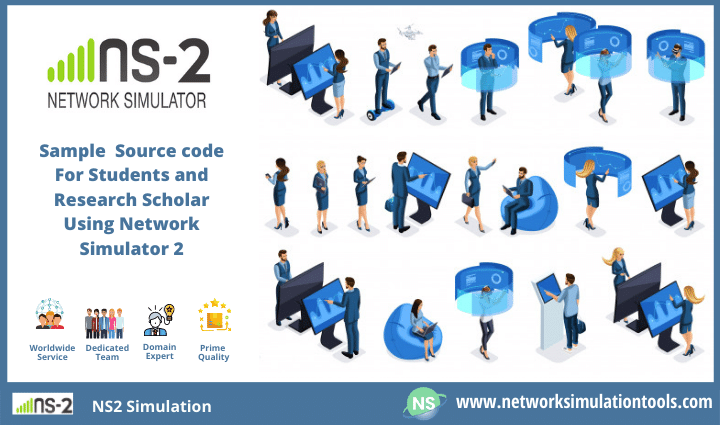NS2 Simulation today, many kinds of network simulators available on the market. Most of the computer networking projects develops with the help of network simulators like Ns2, and also Ns3, etc.
Our organization offers simulation related projects for the engineering students and also Phd scholars also. Both computer science and also Electronic students using Ns2 simulation for their final year projects.
In general, our development team has good knowledge of all types of latest simulation tools. Our experts have deep knowledge of Ns2 concepts. Specifically, in the past seven years, we are hiring the faculty who are reputed to a number of students in network simulation-related fields.
Why Ns2 simulation?
- The real-systems are not available which is complex/costly or dangerous (e.g., space simulations, and also flight simulations)
- The design alternatives (e.g., different system configurations) were also evaluated quickly.
- The complex functions for which closed-form formulas or numerical techniques not available are also evaluated.
Advantages of Ns2 simulation
- Ns2 simulation is cheaper sometimes.
- Sometimes it finds bugs (in design) in an advanced manner.
- Generality: over analytic/numerical techniques, it gives more generality.
- Detail: At an arbitrary level, system details also can be simulated.
The objective of Ns2 simulation
- Performance.
- Direct Measurement.
- Reactive.
- The behavior/characteristics are affected when the user/system is disturbed.
- The simulation can be done only on completed running systems.
- Predictive
Analytical Methods
- The model is available and is computationally efficient when it useful. Most systems are complex and require highly complex mathematical models. Usually, only steady-state can be modelled in Ns2 simulation.
NS2-Simulation
- Ns2 simulation can give more detail than analytical modeling.
- The large design space is explored. It is very useful at that time.
- Dynamic behavior can be studied.
- Programmatic representation of system entities
- Algorithmically, we know how bits and pieces of the system work
- Mathematically, we know possible for some bits
- Implement these algorithms and let them interact
Two main types of simulation
- Discrete event
- Using random number generators are used in discrete points in time.
- Continuous-time
- Continuously, State changes can occur across time.
- Packages
- The number of packages is used in the Ns2 simulation. E.g. OPNET (commercial), NS-2 (open source), OMNeT++
- Levels of detail
- E.g., packet level, flow level
Evaluation spectrum
- Numerical models
- Simulation
- Emulation
- Prototype
- Operational system
Programming a simulation
- Simulated Time: The simulated time is kept by the internal (to simulation program) variable.
- System “state”: The variables maintained by the simulation program is defined as a system “state.”
- e.g., may track number (possibly order) of packets in the queue, current value of retransmission timer
- Events: The system changes state when points in time
- Every event has associated with event timee.g., the arrival of the packet to queue, a departure from the queue precisely at these points in time that simulation must take action (change state and may cause new future events).
- An external environment causes the model for the time between events (probabilistic).
Structure of Ns2 simulation
- A list of future events is maintained and updated by the simulation programs: event list
Need
- A well-defined set of events is maintained.For every event: The simulated system actions, the updating of the event list
Basics of using simulation
- The Network topology, load, output files in Tcl Script are defined in Ns2 simulation.
- Internally, C++ classes based on the tcl scripts are instantiated by Ns2 simulation.
- We can get the output is in the form of trace files.
- Every year we are updates the new titles with new technology on network simulation, which is used for B.E, B.Tech, M.E, M.Tech students, and Phd scholars.
